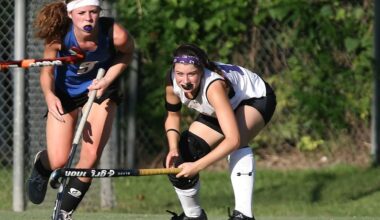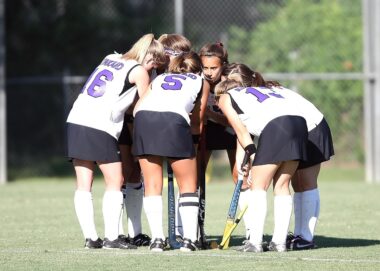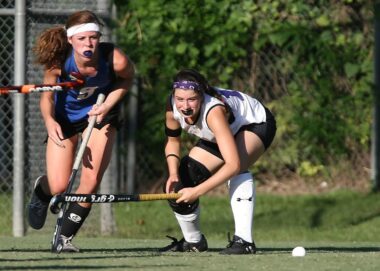Bodyweight Exercises for Field Hockey Circuit Training
Field hockey players greatly benefit from circuit training, particularly when it incorporates bodyweight exercises. These exercises focus on improving strength, flexibility, and endurance, crucial attributes for athletes in this high-intensity sport. Incorporating bodyweight movements allows athletes to build functional strength, aligning closely with the demands placed on them during games. Additionally, these exercises can be performed anywhere, providing versatility in training environments. A balanced circuit should include upper-body, lower-body, and core exercises, ensuring a comprehensive approach. Furthermore, maximizing muscle engagement and reducing injury risk is possible through proper form and varied movement patterns. Popular bodyweight movements can be adjusted in difficulty, catering to players at all skill levels. Engaging in circuit training twice a week can lead to noticeable improvements in on-field performance. Consequently, incorporating such a diverse range of exercises keeps training fresh and exciting. This variation not only aids in maintaining motivation among players but enhances overall physical adaptability, making it a key recommendation for serious field hockey athletes. Assessing personal fitness levels is crucial to tailor the circuit suits each player’s unique requirements and capabilities for optimal results.
To begin designing an effective circuit, players should consider specific bodyweight exercises suited for field hockey. Key movements include push-ups, squats, lunges, and planks, all of which can be adapted. Push-ups target the upper body, enhancing arm strength essential for stick handling. Squats are vital for developing lower body strength, crucial for powerful strikes and maintaining stability. Lunges help improve agility, allowing players to pivot quickly during a game. Lastly, planks are excellent for building core strength, which is critical in maintaining balance and posture on the field. For added variation, bodyweight exercises can be performed in sets or timed intervals. This time-based approach encourages intensity and promotes cardiovascular conditioning. Switching between exercises keeps the training dynamic, effectively challenging different muscle groups and preventing boredom. Additionally, employing circuit-style training encourages social interaction, motivating players through friendly competition. Players can also track their progress, noting improvements in repetitions or time to enhance personal goals. With commitment to this method of training, players can expect improvements in their overall athleticism and readiness for the demands of field hockey.
Sample Circuit Training Routine
Creating an effective bodyweight circuit routine involves planning and organization. For a field hockey training session, a sample circuit could include three rounds of varying exercises, focusing on endurance and strength. The routine can commence with 10 push-ups to work on upper body strength, followed by 15 squats to target the legs. Following this, players can enjoy 20 alternating lunges, promoting leg power and balance. Next, add in 30 seconds of plank hold to work the core muscles, challenging stability. After these initial exercises, include agility training like jumping jacks or high knees for an added cardiovascular element. Transitioning between exercises rapidly maintains heart rates, enhancing stamina over time. After completing the circuit, ensure to incorporate a cool-down period with stretching to aid recovery and flexibility. Recovery not only enhances athletic performance but minimizes injury risk in future workouts. Consistent practice of this routine could raise an athlete’s ability to compete effectively at higher levels. Gradually increasing repetitions or reducing rest times as fitness levels improve can also lead to better results. Consistency in practicing this routine will elevate performance when on the field substantially.
To enhance effectiveness, players should also focus on form during bodyweight exercises. It is essential to maintain proper alignment and technique to engage the targeted muscles fully. For push-ups, players should keep their bodies straight, lowering themselves until their chests near the ground. In squats, maintaining a straight back and ensuring knees do not extend beyond the toes is vital. For lunges, stepping forward should be controlled, emphasizing pushing back up with the heel. The plank position requires keeping a neutral spine while engaging the core to avoid sagging or overextending. These small details matter in execution; good form prevents injury while maximizing workout efficiency. It is beneficial for players to receive feedback from coaches or peers to refine their techniques further. Incorporating mirror checks can also help athletes visualize their posture and make necessary adjustments. Regularly reassessing exercise form contributes to continuous improvement, thus setting a foundation for overall better performance. As players adapt to the routine and challenges get more intense, they will witness significant development in their abilities, making it a worthwhile commitment in their training programs.
Benefits of Bodyweight Training
Bodyweight exercises offer numerous advantages that specifically benefit field hockey players. One primary advantage is improved functional strength, translating directly to better athletic performance on the field. The adaptable nature of bodyweight movements means players can modify exercises based on their individual fitness levels. This aspect promotes inclusivity in training, ensuring everyone can find success regardless of experience. Additionally, because bodyweight exercises rely on an individual’s overall weight for resistance, this helps build muscle without the potential injuries associated with lifting heavy weights. Improved muscular endurance gained through this method allows players to maintain their energy levels throughout the game duration. Enhanced core strength, another significant benefit, translates to better balance and stability. Greater stability enables sharp movements that characterize field hockey, such as quick directional changes and maintaining speed while handling the ball. Moreover, this training style also encourages exceptional coordination skills vital for accurate passing and shooting. Since exercises predominantly mimic functional movements, players receive a workout that prepares them for the physical demands of the game while promoting overall athletic capability improvement, ensuring they’re better equipped for competition.
Incorporating these bodyweight exercises into regular training routines reinforces mental resilience crucial in sports. Circuit training not only builds physical strength but also pushes athletes to overcome mental barriers. Training usually occurs in rounds or intervals, continually challenging players to maintain focus and commitment during each rep. This aspect fosters an enduring mindset, encouraging players to push through fatigue and discomfort. Building this mental fortitude is equally vital as developing physical abilities. Players who engage regularly can also develop a sense of camaraderie as they work together to overcome challenges made through intensive workouts. This social support enhances individual motivation and leads to consistent practice patterns. Moreover, it creates an engaging atmosphere in training sessions where fun and competition blend harmoniously, increasing participation. Players can share tips and celebrate their collective achievements, fostering a positive training environment. This enthusiasm translates into their performance on the field; those who enjoy their training are more likely to give their best efforts during matches. Therefore, such holistic training ensures players develop resilience both in their fitness journey and gameplay strategy, enhancing performance under pressure.
Final Thoughts on Circuit Training
Ultimately, circuit training with bodyweight exercises should be integral to any field hockey player’s training program. The blend of strength, endurance, and agility challenges athletes embodies an approach tailored for their specific needs. Players must approach their training with diligence and consistency, maintaining high workout quality for maximum effectiveness. Furthermore, recognizing progress over time—whether it be improved execution, increased repetitions, or shorter rest periods—encourages players to keep striving for greatness. Building a long-term habit of circuit training supports not just on-field performance but also overall athletic development. It contributes to boosted confidence among players and instills a strong sense of teamwork within training sessions. As athletes build their fitness levels through bodyweight exercises and circuit training, they become more adaptable and resilient in the competitive landscape of field hockey. It is vital to remain committed to this process, as players can witness considerable improvements as they mature and evolve as both individuals and team members. Engaging with coaches and seeking regular feedback can also help modify routines, ensuring they remain effective and appealing. With consistent training efforts, players can expect to elevate their game significantly and enjoy playing field hockey even more.
In conclusion, incorporating bodyweight exercises into circuit training for field hockey is indispensable. The balance between strength, endurance, agility, and flexibility enhances overall athletic performance crucial in matches. Coaching guidance is recommended to forge plans that best suit individual needs and goals alongside the team’s strategies. Beyond physical benefits, the mental toughness gained from consistent practice leads to enhanced resilience during critical moments in games. Bodyweight training fosters teamwork and camaraderie among peers, solidifying bonds and promoting a unified spirit. Keeping the workouts dynamic and fun is essential for maintaining engagement, supporting long-term commitment. Players’ can enjoy challenging their limits and discovering new skill sets through this method. Regardless of experience level, adapting this approach can lead to improved results in performance. Encouragement from peers helps boost morale and solidarity within teams, which is invaluable in sports. As players embark on this training journey, they should embrace the process and celebrate each small victory. Achieving fitness milestones reinforces enthusiasm for the sport itself. So, invest in bodyweight exercises as a core element of circuit training today; it will benefit players in many ways while they enjoy the thrilling aspects of field hockey.





